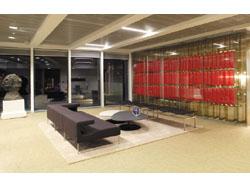Designer Forum - February 2008
Interview with Shashi Caan
For Shashi Caan, designing an interior is about creating a space that offsets our technology-laden, fast paced way of life by promoting a sense of balance, harmony and comfort. She believes that how interiors are designed plays a big role in how people behave—within that space and beyond—and that design affects the subconscious.
“Design has the potential to be glamorous, artistic, edgy, fun and can set us apart,” Caan says. “But often we neglect to realize what it’s doing for us. Generally speaking we don’t think it’s making a cumulative difference, but it is.”
So, for Caan, designing a space that affects a person’s behavior in a particular way is just as important as meeting budgets and deadlines, making the room functional, and coming up with an engaging look.
Flooring has two unique characteristics that have a huge impact on design, Caan says. Unlike the walls or ceiling, flooring is the only surface a human being constantly touches, which produces both a sensation under foot and, in many cases, a unique sound. Second, flooring is one of the few surfaces that many people keep in view while they’re walking.
These two aspects create different sensory experiences and they’re often the first things people experience when they move from one room to another. These qualities seem obvious, she says, but not many people consider how they will affect someone’s behavior.
“Therefore,” she says, “the floor is one of the most important elements. We use it as a major building block in our design considerations.”
Each room in a building has a specific purpose and the environment can either make it easier or more difficult for people to perform in them. Caan tries to determine what she wants people to feel when they transition from space to space, and the experience will be largely influenced by what they feel under their feet and what they see when they’re walking into a room.
For example, if she wants a room that’s more intimate, it’s likely the flooring will be softer. She says the softness almost inspires a person to be more open. “The fact is that most human beings behave in a similar manner” when they experience the same sensations, Caan says.
“If I want serenity, or something more stimulating, then the choices I make with the floor are really critical. The combination of textures becomes really important.”
It’s difficult to make generalizations about how floors should be designed because each project or room is unique, she says.
However, she notes that flooring has gone through general design phases. From 1985 to 1995 symmetrical designs and geometric shapes with large borders were popular, as were tertiary color combinations such as the color teal. Textures ranged from plush to chunky. Then, over the next ten years the emphasis turned toward asymmetry, which became very popular. You might have seen wood flooring “folding” up one wall and onto the ceiling. In addition, thinner, asymmetrical stripes were common, and more advanced lighting systems became an integral part of design. Colors were clearer and more saturated.
Since early this decade, translucency and transparency have been at the forefront, along with gauze-like colors and layering. New materials and looks, arising from the sustainability movement, are being introduced at an almost unprecedented rate. They’re fresh and healthy and often edgy as well.
Over the next decade or so, Caan anticipates that natural products like hemp, jute, and wool will grow in popularity, along with more technologically engineered materials and design solutions.
“In architecture, we’re seeing really unpredictable, contoured shapes, serpentine forms and coils and I suspect some of that will come into the interior,” Caan says. “It will be interesting to see how we manage those design iterations while we continue to address efficiency and the value of real estate. I think we’ll be challenged to design in an ever more efficient, responsible manner.”
Aesthetics won’t follow established patterns partly because designs will increasingly be created on the computer.
“I suspect we’ll also continue to embrace minimalism because we will need balance to counter the visual craziness and the contrast for relief.”
Copyright 2008 Floor Focus
